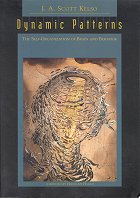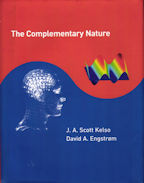For the past twenty years Scott Kelso’s research
has focused on extending the physical concepts of self-organization
and the mathematical tools of nonlinear dynamics
to understand how human beings (and human brains)
perceive, intend, learn, control, and coordinate complex behaviors.
In this book Kelso proposes a new, general framework
within which to connect brain, mind, and behavior.
Kelso’s prescription for mental life breaks dramatically
with the classical computational approach that is still the operative framework
for many newer psychological and neurophysiological studies.
His core thesis is that the creation and evolution of patterned behavior
at all levels—from neurons to mind—are governed by
the generic processes of self-organization.
Both human brain and behavior are shown to exhibit features
of pattern-forming dynamical systems, including multistability,
abrupt phase transitions, crises, and intermittency.
This marvellous book describes a wealth of biological features in
terms of the structure of the underlying dynamical space, its
bifurcations, and its attractors. This dynamical space is
parameterised (say by the frequency of a gait), and as the value of
the parameter changes, the dynamics changes, sometimes significantly
(such as changing from a trot to a gallop). Moreover, the change can
also depend on how the parameter varies: the system exhibits
hysteresis (the frequency of changing from trot to gallop can be
different from that where the gallop drops back to a trot).
The examples start off small, with oscillating finger movements,
muscle flexion, animal gaits, and so on. But the ultimate aim is to
describe certain cognitive processes in the same language. The
behaviour is constrained by the dynamics of the embodied system. This
dynamics is parameterised by "informationally meaningful
quantities", which provides the essential grounding of the
information. By the end of the book, one has seen very many examples
of behaviours at different levels, and the underlying unifying
commonalities shine through clearly.
All the examples are backed up with observational data, which makes
it tough going in places (especially for one who is not a biologist),
but certainly adds conviction to the thesis. There is a plea for
different kinds of experiments -- experiments that manipulate the
parameters in certain controlled ways to investigate and expose the
underlying dynamics.
The language is that of non-linear dynamics, strange attractors,
self-organisation, and emergent properties. But it isn’t some kind of
"gosh wow" buzzword salad; it is solid, thoughtful stuff
that uses these concepts as tools to explain and predict observations,
and build rich scientific models.
This is great science, at the cutting edge of complex systems
theory. Here are some quotes from the text that describe the
underlying themes. They give a flavour of the approach, but read the
whole book to get the full effect, including all the detailed
biological backup.
p1.
The mistake made by many cognitive
scientists is to view symbolic contents as static, timeless entities
that are independent of their origins. Symbols, like the vortices of
the river, may be stable structures or patterns that persist
for a long time, but they are not timeless and unchanging.
p5.
All structures in animate nature are
actually dynamic. We tend to think of some of them as static, but this
is not really the case. Here I will adopt the view that structures and
behaviors are both dynamic patterns separated only by the time scales
on which they live.
p22.
... simple and complicated behaviors
have been shown to emerge from the same dynamical system. Surface
simplicity and surface complexity are both possible outcomes. We don’t
have to posit a different mechanism for each qualitatively different
behavior. Mainstream science tends to make this mistake all the time,
and it leads to a huge proliferation of models. I think that this is
due at least in part to a one-cause-one-effect mentality and
consequent failure to explore the full range of parameter values in a
given experimental system. If one only probes a few parameter values
and if one sees something different in each case, one is inclined to
offer separate explanations. But as we will see again and again in
this book, and as illustrated in the example of the Henon map, how you
move through parameter space determines what you see. And some of what
you see, of course, is very fancy indeed.
p34.
In self-organizing systems, contents and
representations emerge from the systematic tendency of open,
nonequilibrium systems to form patterns. ... a lot of action—quite
fancy, complicated behaviour—can emerge from some relatively
primitive arrangements given the presence of nonlinearities.
p44.
All the hype about chaos and fractals
tends to sweep these questions under the rug while everyone admires
the nice pictures. Don’t get me wrong, I like chaos and fractals. Some
of my best friends do this stuff. I also like numerical simulation and
computer graphics—couldn’t do without them, in fact. They allow you
to see inside a mathematical theory. But, as a scientist, I want to
know what these pictures represent; I especially want to know that the
mathematical equations represent (some small portion of) reality.
There has to be some connection between mathematical formulae and the
phenomena we are trying to understand. Without this connection, as the
popular song goes, we’re "p___ing in the wind." Establishing
a connection between theory and experiment is one of the canons of
science that the "chaos, chaos everywhere" crowd seems to
ignore.
p52.
... to understand coordinated behavior
as self-organized, new quantities have to be introduced beyond the
ones typical of the individual components. Also, we need a variable
that captures not only the observed patterns but transitions between
them.
p53.
Some people say that point attractors
are boring and nonbiological; others say that the only biological
systems that contain point attractors are dead ones. That is sheer
nonsense from a theoretic modeling point of view, as it ignores the
crucial issue of what fixed points refer to. When I talk about fixed
points here it will be in the context of collective variable dynamics
of some biological system, not some analogy to mechanical springs or
pendula.
p.70.
Coordination dynamics is not ordinary
physics. It deals with the dynamics of informationally meaningful
quantities. Coupling in biological systems must reflect functional,
not merely mechanical constraints if behavior is to be adaptive and
successful.
p81.
Such findings suggest that when the many
subsystems are assembled by the central nervous system into
coordinated patterns of behavior, a higher priority is placed on
direction of movement than particular muscle groupings. The cerebral
cortex, it seems, does not plan its actions on the level of muscles.
The self-assembly process appears to be spatially determined and hence
far more abstract than the language of muscles.
p109.
Why should a biological system occupy
the strategic position near boundaries of mode-locked states rather
than residing inside them? ... by residing near the edge, the system
possesses both flexibility and metastability. There is attraction
(the ghost of the fixed point), but no longer any attractor.
p123.
where the system lives in parameter
space dictates the complexity of its behavior
p138.
Without knowledge of spontaneous
coordination tendencies and their dynamics, it is difficult to
understand what is modifiable by the environment, by learning or ...
by intention.
p139.
Living things are open, nonequilibrium
systems. ... ordinary matter under open, nonequilibrium conditions
exhibits self-organization, the creation and evolution of patterned
structures. But in biology, at least so far, processes of
self-organization in open systems have received short shrift. ... For
mainstream biology, the chief source of biological organization is not
its openness, but the fact that organisms are controlled by a program.
... how the program originated is quite irrelevant.
p140.
Far from being equated with a program, a
set of instructions controlling development, the gene, at least to me,
looks more and more like a self-organized, dynamical system. ... In
contrast to artificial machines, the gene is far more likely to be a
self-organized, functional unit, a metastable, dynamical form that
relies on the system’s openness for its creation, integrity, and
self-maintenance.
p141.
an intention is conceived as specific
information acting on the dynamics, attracting the system toward the
intended pattern. This means that intentions are an intrinsic
aspect of the pattern dynamics, stabilizing or destabilizing the
organization that is already there.
p156.
I have often asked myself why a
biological system should have to climb over a barrier in order to
switch state. The transitions I have been talking about in this book
do not involve much energy at all. ... switching is informationally
based. The couplings between things are informational, not force
mediated in the conventional sense. ... parameters (nonspecific and
specific) act to deform or raise and lower basins of attraction
surrounding (nonequilibrium) steady states. The formulation is not of
the quantum tunneling type, but the effects are the same.
p161.
the entire attractor layout is
modified and restructured, sometimes drastically, as a given task is
learned. Learning doesn’t just strengthen the memory trace or the
synaptic connections between inputs and outputs; it changes the
whole system.
p163.
organisms acquire new forms of skilled
behavior on the background of already existing capacities. The initial
state of the organism never corresponds to a disordered random
network, but is already ordered to some degree. Thus, it is very
likely that learning involves the passage from one organized state of
the system to another, rather than from disorder to order.
p173.
the attractor layout may change
qualitatively with learning. This means that learning can take the
form of a phase transition. ... [learning persists because] the
learned pattern has become a stable attractive state of the underlying
coordination dynamics.
p217.
In the low-level feature space, these
prototype patterns constitute attractors. And, because there are
potentially many prototypes, the entire system is multistable. When a
pattern is presented to the system, its state vector is pulled to the
attractor to which it comes closest. Once the specific attractor is
reached, the pattern is recognized.
p223.
Intermittency means that the perceptual
system (and the brain itself?) is intrinsically metastable, living at
the edge of instability where it can switch spontaneously among
collective states. Rather than requiring active processes to
destabilize and switch from one stable state to another (e.g., through
changes in parameter(s), increases in fluctuations), here
intermittency appears to be an inherent built-in feature of the neural
machinery that supports perception.
p234.
what is the relationship between the
geometry of the neuron and its dynamics? Might the fractal hierarchy
of time scales observed in the switching behavior between states be
related to a similar fractal hierarchy in space? Has nature chosen to
couple nonlinear dynamic function with non-Euclidean geometrical
structure? ... most current neural network models, real or artificial,
completely ignore the morphology of the neuron. ... Fractal geometry
and dynamics imply that learning processes are distributed over many
space and time scales and are not simplistically represented as a
single scalar coupling strength quantity.
p284.
If the brain is intrinsically chaotic,
possessing, by definition, an infinite number of unstable periodic
orbits, it has the capacity to match an equally unpredictable
environment. Being chaotic at rest allows the brain access to any of
these unstable orbits to satisfy functional requirements. Thus, when a
cognitive, emotional or environmental demand is made on the organism,
an appropriate orbit or sequence of orbits is selected and then
stabilized through a kind of chaotic synchronization mechanism.

